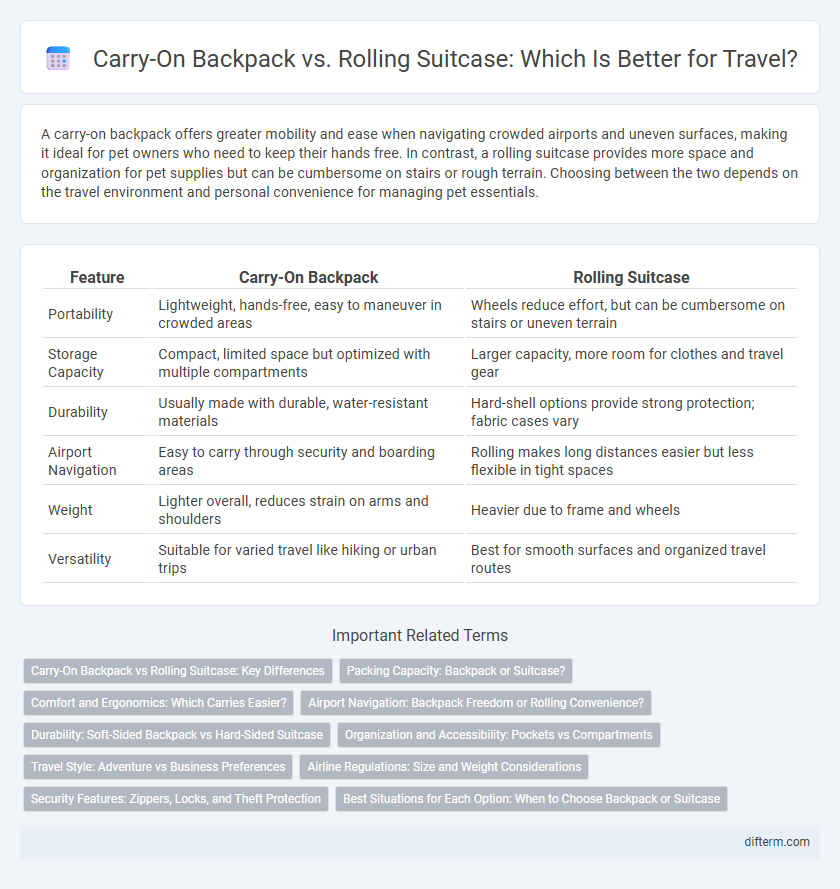A carry-on backpack offers greater mobility and ease when navigating crowded airports and uneven surfaces, making it ideal for pet owners who need to keep their hands free. In contrast, a rolling suitcase provides more space and organization for pet supplies but can be cumbersome on stairs or rough terrain. Choosing between the two depends on the travel environment and personal convenience for managing pet essentials.
Table of Comparison
| Feature | Carry-On Backpack | Rolling Suitcase |
|---|---|---|
| Portability | Lightweight, hands-free, easy to maneuver in crowded areas | Wheels reduce effort, but can be cumbersome on stairs or uneven terrain |
| Storage Capacity | Compact, limited space but optimized with multiple compartments | Larger capacity, more room for clothes and travel gear |
| Durability | Usually made with durable, water-resistant materials | Hard-shell options provide strong protection; fabric cases vary |
| Airport Navigation | Easy to carry through security and boarding areas | Rolling makes long distances easier but less flexible in tight spaces |
| Weight | Lighter overall, reduces strain on arms and shoulders | Heavier due to frame and wheels |
| Versatility | Suitable for varied travel like hiking or urban trips | Best for smooth surfaces and organized travel routes |
Carry-On Backpack vs Rolling Suitcase: Key Differences
Carry-on backpacks offer greater mobility and flexibility for navigating crowded airports and uneven terrain, while rolling suitcases provide easier transport over smooth surfaces with less physical strain. Backpacks typically have smaller capacities and require wearing on the shoulders, which can affect comfort during long trips, whereas rolling suitcases accommodate larger loads and reduce physical effort by using wheels. Choosing between the two depends on travel style, destination, and personal preference for convenience versus capacity.
Packing Capacity: Backpack or Suitcase?
Rolling suitcases typically offer greater packing capacity with structured compartments, making them ideal for longer trips or bulkier items. Carry-on backpacks provide flexible storage with multiple pockets but generally have a smaller volume suited for minimalist or short-duration travel. Choosing between the two depends on the balance of space needs and travel style, with suitcases excelling in organized packing and backpacks favoring mobility.
Comfort and Ergonomics: Which Carries Easier?
Carry-on backpacks distribute weight evenly across shoulders and back, reducing strain during long walks or airport navigation, making them more comfortable for extended periods. Rolling suitcases eliminate back and shoulder pressure by allowing travelers to pull luggage on wheels, which is beneficial on smooth surfaces but can be challenging on stairs, cobblestones, or uneven terrain. Ergonomically, backpacks promote better posture and mobility, while rolling suitcases offer less physical effort but may cause wrist and arm fatigue over time.
Airport Navigation: Backpack Freedom or Rolling Convenience?
Carry-on backpacks offer unmatched freedom in airport navigation, allowing travelers to move quickly through crowded terminals, stairs, and security lines without worrying about maneuvering wheels. Rolling suitcases provide convenience on smooth, flat surfaces like airport corridors and baggage claim areas, reducing physical strain when luggage is heavy. Choosing between the two depends on itinerary specifics, terminal layout, and personal mobility preferences.
Durability: Soft-Sided Backpack vs Hard-Sided Suitcase
Soft-sided carry-on backpacks offer flexibility and lightweight convenience but may show wear more quickly due to fabric exposure and zippers. Hard-sided rolling suitcases are constructed with durable materials like polycarbonate or ABS, providing superior impact resistance and protection for fragile items during transit. In terms of durability, hard-sided suitcases generally outperform soft-sided backpacks by offering enhanced structural integrity and better defense against rough handling.
Organization and Accessibility: Pockets vs Compartments
Carry-on backpacks feature multiple external and internal pockets designed for quick access to essentials like passports, electronics, and snacks, enhancing organization on the go. Rolling suitcases offer spacious, segmented compartments that keep clothing and larger items neatly separated but may require unfolding or repositioning for access. Travelers prioritizing ease of reach and systematic packing benefit from backpacks, while those needing organized storage for bulkier items prefer rolling suitcases.
Travel Style: Adventure vs Business Preferences
Carry-on backpacks suit adventure travelers seeking mobility, durability, and hands-free convenience for rugged environments and unpredictable conditions. Rolling suitcases appeal to business travelers prioritizing organized compartments, professional appearance, and easy navigation through airports and hotels. Travel style dictates luggage choice, with adventurous individuals valuing flexibility and business professionals emphasizing efficiency and presentation.
Airline Regulations: Size and Weight Considerations
Airline regulations strictly govern the size and weight of carry-on backpacks and rolling suitcases, often limiting dimensions to around 22 x 14 x 9 inches and weight to 15-22 pounds depending on the carrier. Carry-on backpacks offer flexibility and easier maneuverability in tight spaces but must comply with overhead bin and under-seat storage rules. Rolling suitcases generally meet these size limits more predictably but can be heavier, affecting weight restrictions and potential additional fees.
Security Features: Zippers, Locks, and Theft Protection
Carry-on backpacks often feature lockable zippers and hidden pockets that enhance theft protection, making them ideal for secure travel in crowded places. Rolling suitcases typically include integrated TSA-approved locks and sturdy zipper designs that deter unauthorized access during airport handling. Travelers prioritizing security should consider backpacks with slash-resistant materials and TSA locks on suitcases for optimal protection.
Best Situations for Each Option: When to Choose Backpack or Suitcase
Backpack suits travelers navigating crowded airports, uneven terrain, or those who prioritize hands-free mobility and compact storage, ideal for hiking, city tours, or short trips. Rolling suitcases excel in smooth environments like airports and hotels, offering organized packing space and ease of transport for longer stays or business travel with heavier loads. Selecting between the two depends on trip duration, destination terrain, and personal mobility preferences.
carry-on backpack vs rolling suitcase Infographic

 difterm.com
difterm.com